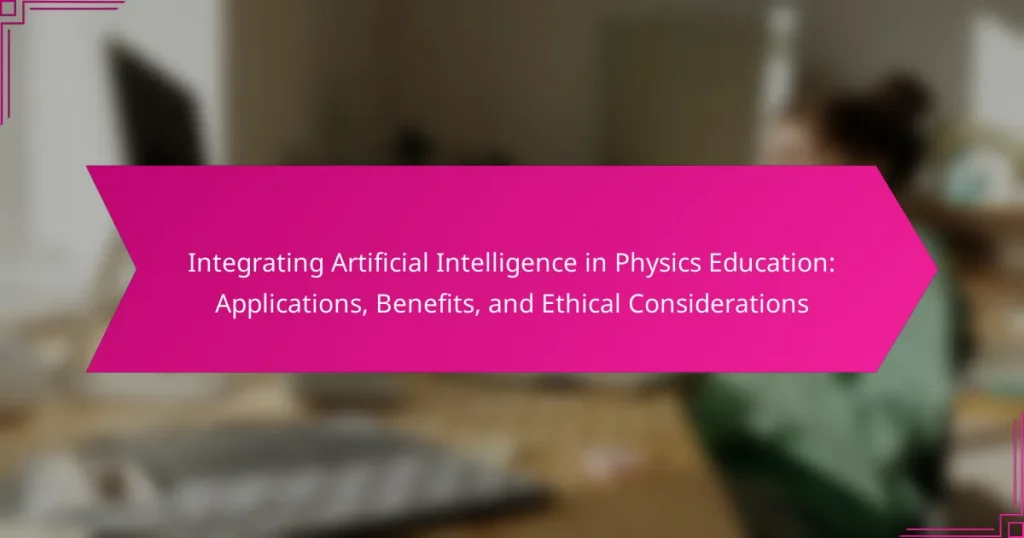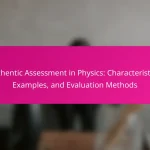Integrating Artificial Intelligence (AI) in physics education enhances personalized learning experiences, data analysis, and student engagement. AI tools can customize educational content to meet individual student needs, facilitating differentiated instruction and accommodating diverse learning styles. Additionally, AI enables the analysis of large datasets to provide insights into student performance, helping educators identify areas for improvement. The implementation of interactive simulations powered by AI further aids in making complex physics concepts more accessible. However, ethical considerations such as data privacy, algorithmic bias, and potential dependency on technology must be addressed to ensure responsible integration of AI in educational settings.
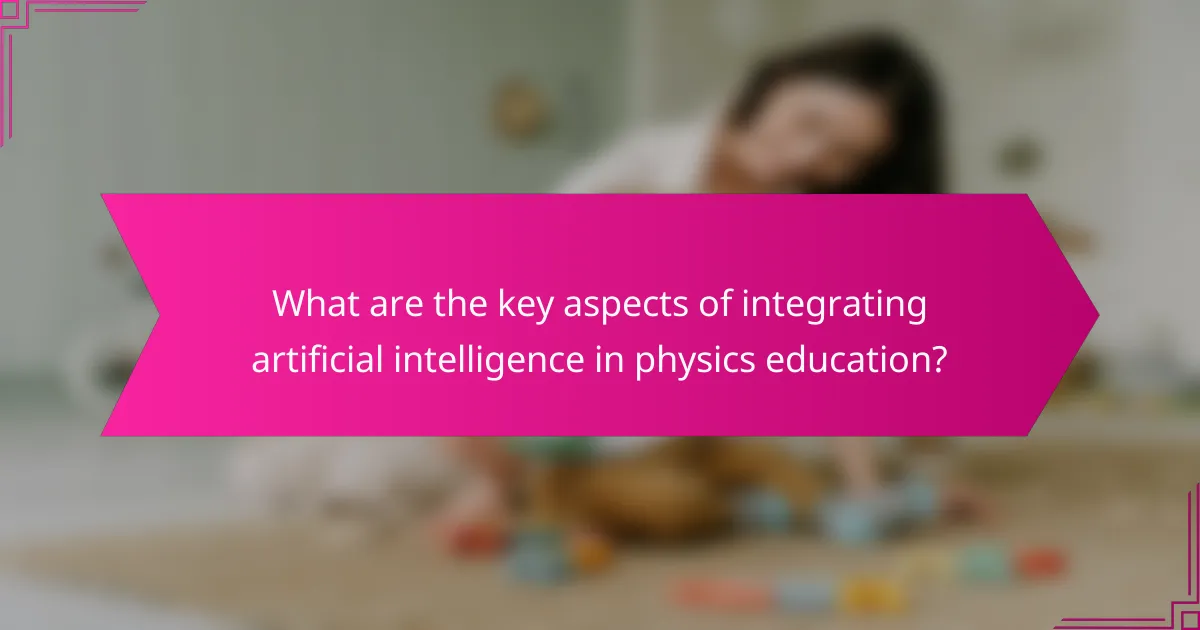
What are the key aspects of integrating artificial intelligence in physics education?
Key aspects of integrating artificial intelligence in physics education include personalized learning experiences, enhanced data analysis, and improved engagement. AI can tailor educational content to individual student needs. This customization allows for differentiated instruction, accommodating various learning styles. AI tools can analyze large datasets to provide insights into student performance. Such analysis helps educators identify areas needing improvement. Additionally, AI can facilitate interactive simulations that enhance conceptual understanding. These simulations make complex physics concepts more accessible. Implementing AI also raises ethical considerations, such as data privacy and bias. Addressing these concerns is crucial for responsible integration.
How does artificial intelligence enhance physics learning experiences?
Artificial intelligence enhances physics learning experiences by providing personalized learning pathways. AI systems analyze student performance and adapt content to meet individual needs. This targeted approach helps address knowledge gaps effectively. Additionally, AI-powered simulations offer interactive environments for complex physics concepts. These simulations allow students to visualize and manipulate variables in real-time. Research indicates that students using AI tools show improved engagement and retention rates. For instance, a study by Kulik and Kulik found that tailored instruction can lead to significant learning gains. Overall, AI’s adaptability and interactive capabilities make physics education more effective and engaging.
What specific AI tools are used in physics education?
Specific AI tools used in physics education include intelligent tutoring systems, simulation software, and automated grading tools. Intelligent tutoring systems, such as Carnegie Learning, provide personalized learning experiences. They adapt to individual student needs and offer tailored feedback. Simulation software like PhET Interactive Simulations allows students to visualize complex physics concepts dynamically. Automated grading tools, such as Gradescope, streamline the assessment process for physics assignments. These tools enhance engagement and improve learning outcomes in physics education.
How do these tools facilitate personalized learning in physics?
Artificial intelligence tools facilitate personalized learning in physics by adapting educational content to individual student needs. These tools analyze student performance data to identify strengths and weaknesses. They provide tailored resources that match each student’s learning pace. AI-driven platforms offer interactive simulations that cater to various learning styles. They also generate customized quizzes and assessments to reinforce understanding. Studies show that personalized learning can lead to improved student engagement and retention of concepts. For example, research by the Bill & Melinda Gates Foundation indicates that personalized learning approaches can enhance academic outcomes significantly.
What are the potential benefits of using AI in physics education?
AI in physics education can enhance personalized learning experiences. It adapts to individual student needs and learning paces. AI tools can provide instant feedback on student performance. This immediate response helps identify areas for improvement. AI can also facilitate interactive simulations of complex physics concepts. These simulations make abstract ideas more tangible for students. Additionally, AI can automate administrative tasks for educators. This allows teachers to focus more on instruction and student engagement. Studies have shown that AI-driven educational tools improve student outcomes in STEM fields.
How can AI improve student engagement in physics?
AI can improve student engagement in physics through personalized learning experiences. It tailors educational content to match individual learning styles and paces. Adaptive learning platforms analyze student performance in real-time. They provide targeted resources and feedback based on specific needs. AI-driven simulations enhance understanding of complex physics concepts. These tools allow students to visualize and interact with abstract ideas. Gamification elements in AI applications increase motivation and participation. Studies show that interactive tools lead to higher retention rates. Overall, AI fosters a more engaging and effective learning environment in physics education.
What outcomes can be measured to assess the effectiveness of AI in physics education?
Outcomes that can be measured to assess the effectiveness of AI in physics education include student engagement, learning outcomes, and retention rates. Student engagement can be evaluated through participation in AI-driven interactive learning activities. Learning outcomes can be measured using standardized assessments to compare AI-assisted learning with traditional methods. Retention rates can be tracked to determine if AI tools improve long-term knowledge retention. Additionally, feedback from students regarding their learning experience can provide qualitative data on AI’s impact. These metrics collectively offer insights into the overall effectiveness of AI in enhancing physics education.
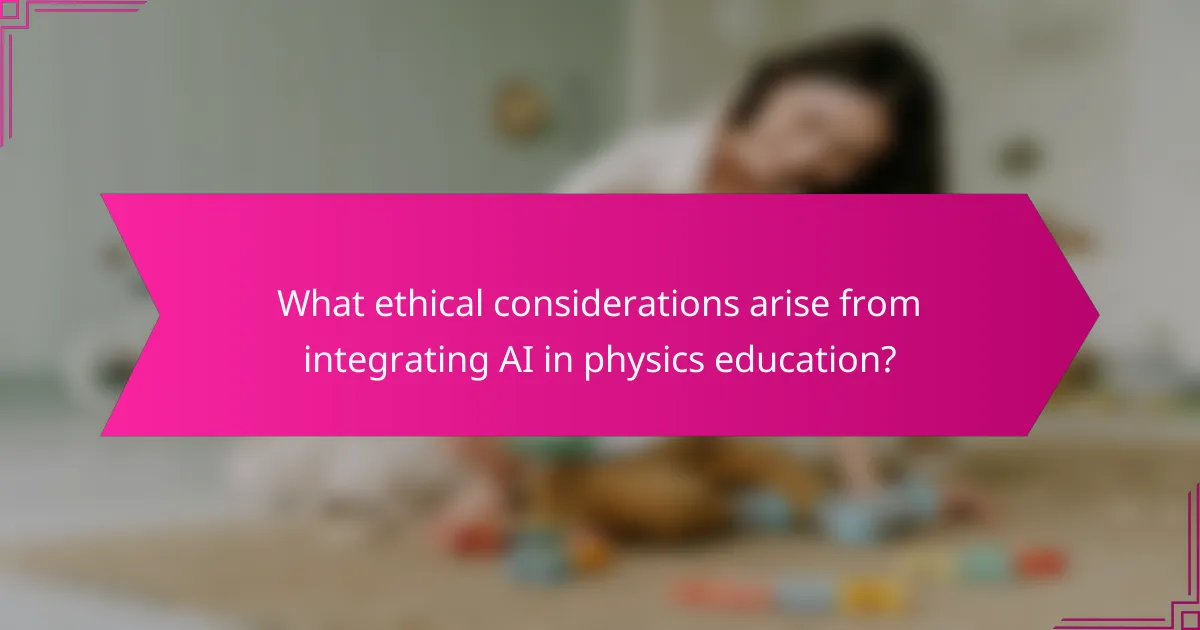
What ethical considerations arise from integrating AI in physics education?
Ethical considerations in integrating AI in physics education include data privacy, bias, and the potential for dependency on technology. Data privacy concerns arise from the collection and use of student data by AI systems. For instance, educational AI tools may track student performance and behavior, raising questions about consent and data security. Bias in AI algorithms can lead to unequal educational outcomes, as these systems may reflect existing societal biases. This can affect how different groups of students are assessed and supported. Dependency on AI tools may hinder critical thinking and problem-solving skills, as students might rely too heavily on technology for answers. These considerations highlight the need for careful implementation and oversight when integrating AI into educational settings.
How does AI impact student privacy and data security in educational settings?
AI significantly impacts student privacy and data security in educational settings. AI systems often require access to vast amounts of student data for personalized learning. This data can include sensitive information such as academic records and behavioral patterns. The collection and storage of such data raise concerns about unauthorized access and data breaches.
According to a report by the National Center for Education Statistics, 70% of educational institutions have experienced a data breach. AI algorithms can inadvertently expose personal information if not properly secured. Furthermore, the use of AI can lead to surveillance concerns, as monitoring tools may track student activities beyond academic performance.
Educational institutions must implement strict data protection policies to safeguard student information. Compliance with regulations like FERPA (Family Educational Rights and Privacy Act) is crucial for maintaining data security. Overall, while AI enhances educational experiences, it poses significant challenges to student privacy and data security.
What measures can be taken to protect student data when using AI?
Implementing strong data encryption is essential to protect student data when using AI. Encryption secures data during transmission and storage, making it unreadable to unauthorized users. Regular audits of data access and usage can help identify potential vulnerabilities. Establishing strict access controls ensures that only authorized personnel can access sensitive information. Educating students and staff about data privacy is crucial for fostering a culture of security. Compliance with data protection regulations, such as FERPA in the U.S., mandates safeguarding student information. Using anonymization techniques can further reduce the risk of exposing personal data. Finally, conducting risk assessments regularly helps to identify and mitigate new threats to data security.
How can educators ensure transparency in AI algorithms used in physics education?
Educators can ensure transparency in AI algorithms used in physics education by implementing clear documentation practices. This includes providing detailed explanations of the algorithms’ functionalities and decision-making processes. Educators should also involve students in discussions about how AI tools operate. Regularly updating stakeholders on algorithm changes enhances understanding and trust. Additionally, providing access to algorithmic data allows for independent evaluation. Research shows that transparency improves user confidence and engagement. A study by Lipton (2016) emphasizes the importance of explainability in AI systems for effective educational outcomes.
What are the implications of bias in AI applications for physics education?
Bias in AI applications for physics education can lead to unequal learning opportunities. It may favor certain demographics over others, impacting student engagement and achievement. For instance, biased algorithms might prioritize content that aligns with specific cultural perspectives. This can reinforce existing disparities in educational outcomes. Research indicates that biased AI can perpetuate stereotypes, affecting students’ self-perception and motivation. Consequently, educators must critically assess AI tools to ensure fairness and inclusivity. Addressing bias is essential for fostering an equitable learning environment in physics education.
How can biases in AI systems affect learning outcomes for students?
Biases in AI systems can negatively influence learning outcomes for students. These biases may lead to unfair treatment in grading and assessment. For example, if an AI system is trained on biased data, it may favor certain demographic groups. This can result in unequal access to resources and support. Research shows that biased algorithms can perpetuate existing inequalities in education. A study by the National Bureau of Economic Research found that biased AI can exacerbate achievement gaps. Therefore, addressing biases is crucial to ensure equitable learning experiences for all students.
What strategies can be employed to mitigate bias in AI tools for physics?
To mitigate bias in AI tools for physics, diverse training data should be employed. This ensures that AI models learn from a wide range of scenarios and perspectives. Regular audits of AI algorithms can identify and address biases in their outputs. Implementing fairness metrics during model evaluation helps quantify bias levels. Collaboration with interdisciplinary teams can bring in varied expertise and viewpoints. Continuous feedback from users can highlight biased outcomes and improve AI systems. Furthermore, transparency in AI decision-making processes fosters trust and accountability. These strategies are supported by research from the MIT Media Lab, which emphasizes the importance of diversity and transparency in AI development.
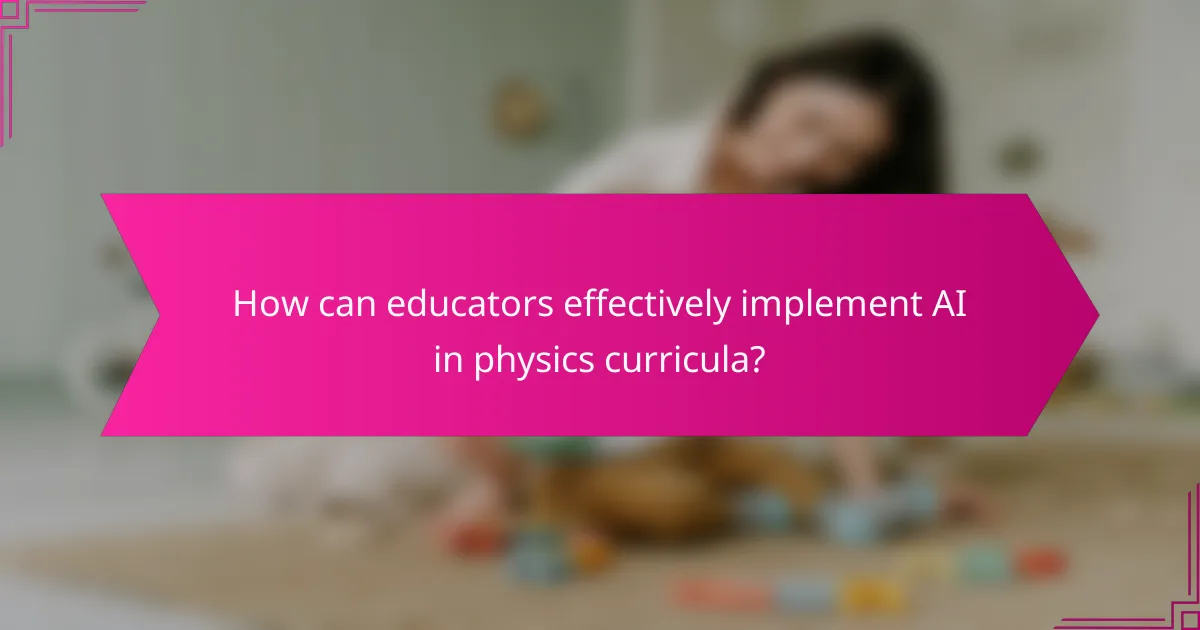
How can educators effectively implement AI in physics curricula?
Educators can effectively implement AI in physics curricula by integrating AI-based tools and resources into teaching methods. These tools can provide personalized learning experiences tailored to individual student needs. For instance, adaptive learning platforms can assess student progress and adjust content accordingly. Additionally, simulations powered by AI can enhance understanding of complex physics concepts. Educators can also use AI for data analysis in experiments, allowing students to focus on interpretation rather than computation. Research shows that AI can improve engagement and learning outcomes in STEM subjects. A study by Luckin et al. (2016) highlights how AI can support teachers in providing feedback and fostering student collaboration. By incorporating these strategies, educators can create a more interactive and effective physics learning environment.
What best practices should educators follow when integrating AI in physics education?
Educators should follow several best practices when integrating AI in physics education. First, they must ensure alignment with educational goals. AI tools should enhance learning objectives and not distract from them. Second, educators should provide comprehensive training on AI tools for both teachers and students. This training enhances effective usage and understanding. Third, they should incorporate AI to personalize learning experiences. Adaptive learning technologies can cater to individual student needs. Fourth, educators must promote ethical considerations in AI usage. Discussing data privacy and algorithmic bias is essential. Fifth, they should encourage collaboration between students. AI can facilitate group projects and peer learning. Lastly, continuous evaluation of AI tools is necessary. Regular assessments ensure these tools remain effective and relevant.
How can teachers be trained to use AI tools effectively in their classrooms?
Teachers can be trained to use AI tools effectively in their classrooms through structured professional development programs. These programs should include hands-on workshops that focus on practical applications of AI in education. Training should cover various AI tools and their functionalities relevant to physics education. Educators need to learn how to integrate AI into lesson planning and classroom activities. Collaboration with AI experts can enhance understanding and implementation. Continuous support and resources should be provided to ensure teachers feel confident using AI. Research shows that effective training improves teachers’ technology integration skills and student engagement. According to a study by the International Society for Technology in Education, teachers who receive targeted training are more likely to adopt innovative teaching methods.
What resources are available to support the integration of AI in physics education?
Resources available to support the integration of AI in physics education include online platforms, software tools, and research studies. Online platforms such as Coursera and edX offer courses on AI applications in education. Software tools like PhET Interactive Simulations provide interactive physics simulations enhanced by AI. Research studies, such as “Artificial Intelligence in Education: A Review” by K. C. K. Wong and M. W. K. Cheung, detail effective strategies for using AI in classrooms. Additionally, organizations like the American Association of Physics Teachers provide guidelines and resources for educators. These resources collectively facilitate the effective integration of AI in physics education.
What challenges might educators face when adopting AI in physics education?
Educators may face several challenges when adopting AI in physics education. One significant challenge is the lack of adequate training in AI technologies. Many educators are not familiar with how to implement AI tools effectively in their teaching. This can lead to underutilization of AI resources. Another challenge is the potential for increased workload. Educators may need to spend additional time managing AI systems alongside traditional teaching methods.
Additionally, there can be concerns about data privacy and security. AI systems often require access to student data, raising ethical questions. Some educators might also struggle with integrating AI into existing curricula. This can create resistance to change among faculty accustomed to traditional teaching methods. Lastly, the cost of implementing AI technologies can be a barrier for many educational institutions. Budget constraints may limit access to necessary resources and tools.
How can educators overcome resistance to AI technology in their teaching practices?
Educators can overcome resistance to AI technology by providing targeted training and support. Training sessions can help educators understand AI’s capabilities and applications. Demonstrating successful case studies can alleviate concerns about AI’s effectiveness. Engaging educators in hands-on workshops fosters confidence in using AI tools. Encouraging collaboration among educators can create a supportive community. Addressing ethical concerns openly builds trust in AI technology. Continuous feedback loops allow educators to express concerns and suggest improvements. Research shows that professional development increases technology adoption rates in education.
What are common misconceptions about AI in education that need addressing?
Common misconceptions about AI in education include the belief that AI will replace teachers. In reality, AI is designed to assist educators, not replace them. Another misconception is that AI can personalize learning perfectly for every student. While AI can provide tailored resources, it still requires human oversight to be effective. Many also think that AI only benefits students with advanced skills. However, AI can support learners at all levels by identifying their unique needs. Additionally, some believe that AI is unbiased in its assessments. Research shows that AI systems can inherit biases from their training data, which needs addressing. Lastly, there is a misconception that AI in education is too expensive for most institutions. Many AI tools are now affordable and accessible, making them viable for diverse educational settings.
What future trends can we expect in AI applications for physics education?
Future trends in AI applications for physics education include personalized learning experiences. AI can adapt content to individual student needs and learning paces. Another trend is the use of virtual labs powered by AI. These labs provide interactive simulations for complex physics concepts. Additionally, AI-driven analytics will enhance student assessment and feedback. This data can identify learning gaps and suggest tailored resources. Collaborative AI tools will also facilitate peer learning and group projects. Lastly, AI will support educators by automating administrative tasks, allowing more focus on teaching. These trends are expected to transform how physics is taught and learned.
How might advancements in AI technology shape the future of physics learning?
Advancements in AI technology will significantly enhance physics learning. AI can provide personalized learning experiences tailored to individual student needs. It can analyze student performance and adapt content accordingly. AI-driven simulations can offer interactive environments for complex physics concepts. These simulations can visualize phenomena that are difficult to observe in real life. Additionally, AI can facilitate immediate feedback, helping students correct misconceptions promptly. Research indicates that adaptive learning technologies improve student engagement and understanding. For instance, a study by Knewton found that personalized learning platforms increased student performance by 20%. Overall, AI’s role in physics education will foster deeper comprehension and greater accessibility.
What role will collaboration between AI developers and educators play in future innovations?
Collaboration between AI developers and educators will drive future innovations in educational technology. This partnership enables the creation of AI tools tailored to enhance learning experiences. Educators provide insights into pedagogical needs and student engagement strategies. AI developers leverage this feedback to design effective, user-friendly applications. Together, they can develop adaptive learning systems that personalize education. These systems can analyze student performance and adjust content accordingly. Research indicates that personalized learning can improve student outcomes significantly. For example, a study by the Bill & Melinda Gates Foundation found that personalized learning approaches can lead to better academic performance. Therefore, collaboration will be essential in shaping the future of education through AI integration.
What practical tips can educators use for integrating AI in their physics classrooms?
Educators can integrate AI in physics classrooms by utilizing AI-driven simulations. These tools allow students to visualize complex concepts like electromagnetism and quantum mechanics. Additionally, educators can use AI for personalized learning experiences. AI can analyze student performance and adapt lessons accordingly. Implementing chatbots can provide instant support for student queries. Educators can also incorporate AI-based assessment tools for real-time feedback. Using AI to analyze data from experiments enhances understanding of scientific methods. Finally, collaborating with AI experts can help educators stay updated on the latest technologies.
Integrating artificial intelligence (AI) in physics education focuses on enhancing personalized learning experiences, improving student engagement, and facilitating data analysis. Key AI tools, such as intelligent tutoring systems and simulation software, are employed to tailor educational content to individual student needs, thereby addressing diverse learning styles and knowledge gaps. The article also discusses the potential benefits of AI, including immediate feedback and interactive simulations, while highlighting ethical considerations such as data privacy and algorithmic bias. Additionally, it outlines best practices for educators to effectively implement AI in physics curricula, ensuring a balanced approach to technology integration.
